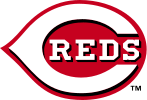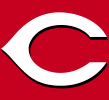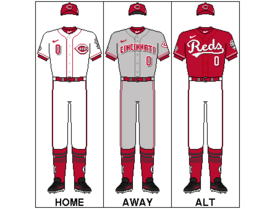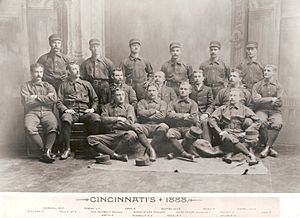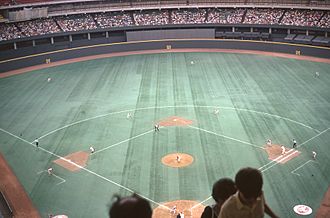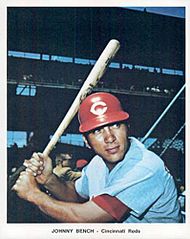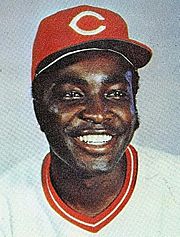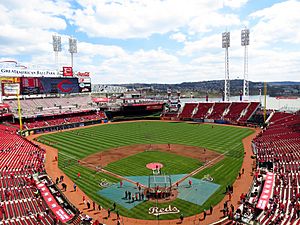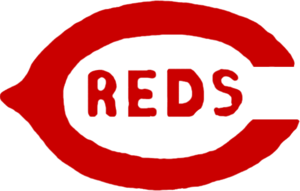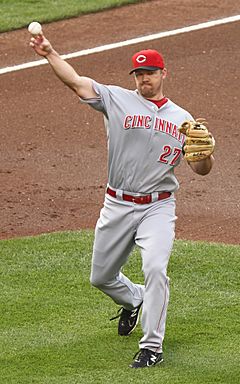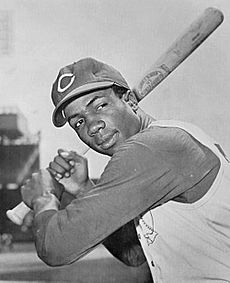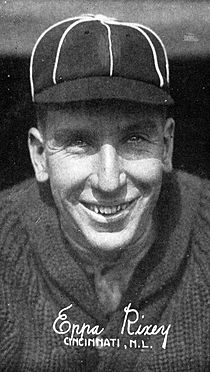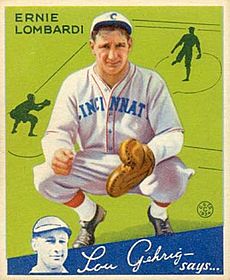Cincinnati Reds facts for kids
Quick facts for kids Cincinnati Reds |
|||||
|---|---|---|---|---|---|
|
|||||
|
|||||
| Major league affiliations | |||||
|
|||||
| Current uniform | |||||
| Retired numbers | |||||
| Colors | |||||
|
|||||
| Name | |||||
|
|||||
| Other nicknames | |||||
|
|||||
| Ballpark | |||||
|
|||||
| Major league titles | |||||
| World Series titles (5) |
|
||||
| NL Pennants (9) |
|
||||
| AA Pennants (1) | 1882 | ||||
| NL Central Division titles (3) |
|
||||
| NL West Division titles (7) |
|
||||
| Wild card berths (2) |
|
||||
| Front office | |||||
| Principal owner(s) | Bob Castellini | ||||
| President | Phillip J. Castellini | ||||
| President of baseball operations | Nick Krall | ||||
| General manager | Brad Meador | ||||
| Manager | Terry Francona | ||||
The Cincinnati Reds are a professional baseball team from Cincinnati, Ohio. They play in Major League Baseball (MLB) as part of the National League (NL) Central Division. The team started in 1881 as a founding member of the American Association. They later joined the NL in 1890.
From 1969 to 1993, the Reds played in the NL West division. In 1994, they moved to the Central division. In the 1970s, the Reds were one of the best teams in baseball. They were known as the "Big Red Machine" and won the World Series in 1975 and 1976. Famous players from this era include Johnny Bench, Joe Morgan, and Tony Pérez. The Reds have won five World Series championships, nine NL pennants, one AA pennant, and 10 division titles. Their home games are played at Great American Ball Park, which opened in 2003.
Contents
- History of the Cincinnati Reds
- How the Reds Began (1881–1889)
- Joining the National League Again (1890–1911)
- From Redland Field to the Great Depression (1912–1932)
- Championships and a New Era (1933–1940)
- The Reds in the Mid-20th Century (1941–1969)
- The Big Red Machine Era (1970–1976)
- The Machine Changes (1977–1989)
- World Championship and a New Era (1990–2002)
- The Reds Today (2003–Present)
- Ballparks Where the Reds Play
- Logos and Uniforms of the Reds
- Awards and Achievements
- MLB All-Star Games Hosted by the Reds
- Team Rivalries
- Reds Media Coverage
- Community Involvement
- Team Roster
- Minor League Teams
- See also
History of the Cincinnati Reds
How the Reds Began (1881–1889)
The Cincinnati Reds team started after an earlier Cincinnati team was removed from the National League. This happened because the team sold beer and played games on Sundays, which the league president didn't like. In 1881, a new independent team called the Red Stockings was formed.
This new team helped create the American Association (AA). The Reds became a founding member of this new league. In 1882, the Reds won the first AA championship. Key players included Hick Carpenter, Bid McPhee, and Will White.
Joining the National League Again (1890–1911)
The Cincinnati Red Stockings left the American Association in 1889. They joined the National League, which was growing stronger. The team shortened its name to the Reds. For many years, the team didn't finish very high in the standings.
At the start of the 1900s, the Reds had great hitters like Sam Crawford and Cy Seymour. In 1905, Seymour won the batting title with a .377 average. In 1911, Bob Bescher stole 81 bases, which is still a team record.
From Redland Field to the Great Depression (1912–1932)
In 1912, the Reds opened a new stadium called Redland Field. It was later renamed Crosley Field in 1934. The team started to improve in the late 1910s. In 1919, manager Pat Moran led the Reds to win the NL championship.
The 1919 team had star hitters Edd Roush and Heinie Groh. Their pitchers included Hod Eller and Harry "Slim" Sallee. The Reds won the World Series against the Chicago White Sox. This championship was later affected by a scandal involving the White Sox. After 1926, the Reds struggled for many years. By 1931, the team faced financial difficulties.
Championships and a New Era (1933–1940)
Powel Crosley, Jr., a successful businessman, bought the Reds in 1933. He hired Larry MacPhail as general manager. Crosley helped the team grow its fan base and improve its minor league system. The Reds became known for many "firsts" during this time.
Crosley Field hosted the first night game in 1935, which also featured the first baseball fireworks show. In 1938, Johnny Vander Meer became the only pitcher in MLB history to throw two no-hitters in a row. The Reds had strong pitchers like Vander Meer, Paul Derringer, and Bucky Walters. Their offense also improved.
By 1938, the Reds, led by manager Bill McKechnie, were playing much better. Ernie Lombardi was named the National League's Most Valuable Player in 1938. In 1939, the Reds won the National League championship but lost the World Series to the New York Yankees. In 1940, the Reds won the NL championship again. They then won the World Series, beating the Detroit Tigers 4 games to 3. Frank McCormick was the 1940 NL MVP.
The Reds in the Mid-20th Century (1941–1969)
After the 1940 championship, the Reds faced challenges due to World War II and aging players. They often finished in the lower half of the standings. In 1944, Joe Nuxhall, at just 15 years old, pitched for the Reds. He became the youngest player ever in a major league game, a record that still stands.
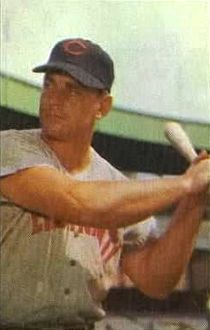
In 1953, the team changed its name to the "Redlegs" for a few years. This was to avoid any connection with the political meaning of the word "red" at the time. The team's logo was also changed to remove the word "REDS." They returned to being called the "Reds" in 1959.
In 1956, the Redlegs, led by Rookie of the Year Frank Robinson, hit 221 home runs, tying an NL record. By 1961, Robinson was joined by players like Vada Pinson and Wally Post. Pitchers Joey Jay and Jim O'Toole led the pitching staff.
The Reds won the 1961 National League championship. However, they were defeated by the New York Yankees in the World Series. The Reds had winning seasons throughout the 1960s but didn't win another championship. In 1964, they lost the championship by just one game. Their manager, Fred Hutchinson, sadly passed away from cancer shortly after the 1964 season.
After the 1965 season, the Reds made a trade that sent star player Frank Robinson to the Baltimore Orioles. Robinson went on to win the MVP award and the Triple Crown in 1966. The Reds didn't fully recover until the "Big Red Machine" era began in the 1970s.
Starting in the 1960s, the Reds' minor league system began producing many talented players. These included Jim Maloney, Pete Rose, Tony Pérez, Johnny Bench, and Dave Concepción. In 1967, Bob Howsam became the general manager. He made smart moves to bring in more key players. The Reds played their final game at Crosley Field on June 24, 1970, winning 5–4.
The Reds had strict rules about player appearance, requiring them to shave and cut their hair. This rule lasted for about 30 years. They also had rules about shoe colors, which players found boring. In 1985, a compromise allowed players to add red marks to their black shoes.
The Big Red Machine Era (1970–1976)
In 1970, George "Sparky" Anderson became the Reds' manager. The team began an amazing decade, with a lineup known as "the Big Red Machine." They moved into Riverfront Stadium on June 30, 1970. The Reds started the 1970 season by winning 70 of their first 100 games.
Early stars included Johnny Bench, Tony Pérez, Pete Rose, and Lee May. Pitchers like Gary Nolan and Don Gullett led the staff. The Reds easily won the NL West and the NL pennant in 1970. However, they lost the World Series to the Baltimore Orioles in five games.
After a tough 1971 season, the Reds made some big trades. They acquired Joe Morgan, César Gerónimo, and Jack Billingham. Dave Concepción became a star at shortstop. In 1971, George Foster also joined the team.
The 1972 Reds won the NL West again. They defeated the Pittsburgh Pirates in a five-game playoff. They then faced the Oakland Athletics in the World Series. Six of the seven games were decided by just one run. Oakland won the series in seven exciting games.
The Reds won their third NL West title in 1973 after a great comeback in the second half of the season. However, they lost the NL pennant to the New York Mets in five games. Game 3 of that series had a lot of controversy. Fans at Shea Stadium reacted strongly to Pete Rose after he got into a scuffle with a Mets player.
In 1974, the Reds won 98 games but finished second to the Los Angeles Dodgers. The 1974 season started with excitement as Hank Aaron of the Atlanta Braves tied Babe Ruth's home run record against the Reds.
By 1975, the Big Red Machine lineup was set. It included the "Great Eight" starting players: Johnny Bench (catcher), Tony Pérez (first base), Joe Morgan (second base), Dave Concepción (shortstop), Pete Rose (third base), Ken Griffey (right field), César Gerónimo (center field), and George Foster (left field). The pitching staff was strong with Don Gullett, Fred Norman, and Gary Nolan.
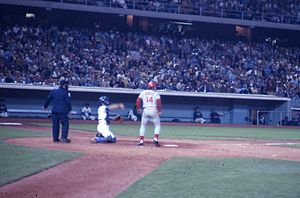
In the 1975 season, Cincinnati won the NL West with 108 victories. They then swept the Pittsburgh Pirates to win the NL pennant. They faced the Boston Red Sox in the World Series. Game 6 is considered one of the best World Series games ever. The Red Sox won that game dramatically in 12 innings. However, Cincinnati won Game 7 the next day, with Joe Morgan's hit securing their first championship in 35 years. The Reds have not lost a World Series game since that time, winning nine straight.
The 1976 season saw the same starting eight players. The Reds won the NL West by 10 games. They went undefeated in the postseason, sweeping the Philadelphia Phillies. They then swept the New York Yankees in the World Series. This made the Reds the first NL team since 1922 to win back-to-back World Series championships.
The Machine Changes (1977–1989)
After the 1976 season, the Big Red Machine began to change. Popular player Tony Pérez was traded, and pitcher Don Gullett left the team. In 1977, the Reds acquired pitcher Tom Seaver from the New York Mets.
In his last season as a Red, Pete Rose had a thrilling hitting streak of 44 games, tying for the second-longest ever. He also got his 3,000th hit that season. In 1978, Tom Seaver pitched the only no-hitter of his Hall of Fame career.
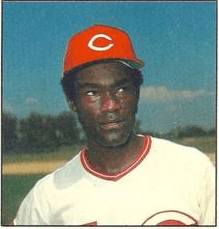
After the 1978 season, manager Sparky Anderson was fired. Pete Rose left the team to play for the Philadelphia Phillies. In 1979, the Reds won the NL West again, led by Seaver's pitching. However, they lost to the Pittsburgh Pirates in the playoffs.
The 1981 Reds had the best overall record in baseball. But due to a mid-season players' strike, they finished second in their division in both halves of the season and missed the playoffs. By 1982, the Reds struggled, losing 101 games. Johnny Bench retired a year later.
In 1984, Pete Rose returned to the Reds as a player-manager. He became the all-time hits leader during this time. In 1988, Tom Browning threw a perfect game. Eric Davis became the first player in baseball history to hit at least 35 home runs and steal 50 bases. Chris Sabo was the 1988 National League Rookie of the Year. In 1989, Rose was banned from baseball due to accusations of betting on games.
World Championship and a New Era (1990–2002)
In 1990, the Reds, led by new manager Lou Piniella, surprised everyone by leading the NL West from start to finish. They won their first nine games and kept their lead all year. Key players included Chris Sabo, Barry Larkin, Eric Davis, Paul O'Neill, and Billy Hatcher. Their strong pitchers were José Rijo, Tom Browning, and the "Nasty Boys" bullpen of Rob Dibble, Norm Charlton, and Randy Myers.
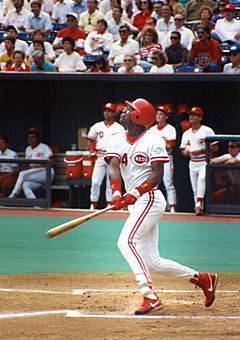
The Reds defeated the Pittsburgh Pirates in the NLCS. They then swept the heavily favored Oakland Athletics in four games in the World Series. This extended their World Series winning streak to nine consecutive games.
In 1992, the Reds had a winning season but finished second in their division. After the 1992 season, team owner Marge Schott faced controversy for inappropriate comments. Major League Baseball prevented her from running the team day-to-day during the 1993 season.
For the 1993 season, Tony Pérez briefly managed the team before Davey Johnson took over. Under Johnson, the Reds improved. In 1994, the Reds were in the new National League Central Division. They finished first in their division before a players' strike ended the season early. In 1995, the Reds won the division again, led by MVP Barry Larkin. They won their first playoff series but lost to the Atlanta Braves.
Owner Marge Schott decided to replace manager Johnson with Ray Knight after the 1995 season. The team struggled under Knight. Schott faced more controversy in 1996 and agreed to step away from daily operations until 1998. In 1999, she sold most of her ownership in the team.
In 1999, the Reds won 96 games under manager Jack McKeon. However, they lost a one-game playoff to the New York Mets and missed the postseason. McKeon was fired after the 2000 season, even though he was named NL Manager of the Year in 1999. The Reds did not have another winning season until 2010.
The Reds Today (2003–Present)

Riverfront Stadium was torn down in 2002. Great American Ball Park opened in 2003. Fans had high hopes for the team, which included local stars like Ken Griffey Jr., Barry Larkin, and Sean Casey. Even with a new stadium and more fans, the Reds continued to lose. The team's farm system (where young players develop) was not strong.
In 2004, Ken Griffey Jr. hit his 500th home run. Adam Dunn became a consistent home run hitter. The Reds continued to struggle with pitching. In 2006, Robert Castellini became the new owner. He hired Wayne Krivsky as general manager. Krivsky is credited with improving the team's farm system.
The Reds did not have winning records in 2008 and 2009. In 2010, with NL MVP Joey Votto and Gold Glove winners Brandon Phillips and Scott Rolen, the Reds had a 91–71 record and won the NL Central championship. They lost in the first round of the playoffs to the Philadelphia Phillies.
In 2012, the Reds won the NL Central Division Title again. On September 28, Homer Bailey pitched a no-hitter against the Pittsburgh Pirates. The Reds finished with a 97–65 record. They won their first two playoff games against the San Francisco Giants but then lost three straight at home, losing the series.
In 2013, Homer Bailey pitched another no-hitter, making him one of only three Reds pitchers with two career no-hitters. After losing six games in a row to end the 2013 season, including a playoff game, manager Dusty Baker was fired.
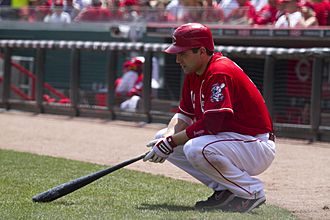
Bryan Price became the new manager in 2013. The team had star players like pitchers Johnny Cueto and Aroldis Chapman, and hitters Todd Frazier, Joey Votto, and Brandon Phillips. However, the Reds struggled and finished in fourth place in their division. The team traded away several key players in 2015 and 2016, including Johnny Cueto, Todd Frazier, and Aroldis Chapman.
In 2020, the Reds made the postseason for the first time since 2013. The season was shorter due to the COVID-19 pandemic. The Reds lost their first-round series to the Atlanta Braves. In 2021, the Reds finished third in the NL Central with a winning record.
The 2022 season was tough for the Reds, as they started with a very poor record and finished with 62 wins and 100 losses. The 2023 season saw the Reds improve significantly. They were in the race for a playoff spot until the very end, finishing with 82 wins and 80 losses. Young players like Spencer Steer, Matt McLain, and Elly De La Cruz led the team. De La Cruz made headlines by hitting for the cycle in his 15th career game.
The 2024 season started strong for the Reds, but they struggled in May and fell out of playoff contention. On September 22, 2024, the Reds fired manager David Bell. On October 4, 2024, the team announced that Terry Francona was hired as the new manager.
Ballparks Where the Reds Play
The Cincinnati Reds play their home games at Great American Ball Park. It is located in downtown Cincinnati. The ballpark opened in 2003 and cost $290 million to build. It can hold 42,271 fans. The stadium also has the Cincinnati Reds Hall of Fame, where fans can learn about the team's history.
Great American Ball Park is the seventh home stadium for the Reds. It was built next to where Riverfront Stadium (later called Cinergy Field) used to be. The Reds have played in several other parks throughout their history, including Bank Street Grounds, League Park I, League Park II, Palace of the Fans, and Crosley Field. Crosley Field was their home for 58 years and saw two World Series titles. Riverfront Stadium, where the "Big Red Machine" played, saw three World Series titles.
The Reds hold their spring training in Goodyear, Arizona, at Goodyear Ballpark. They moved there in 2010 and share the park with the Cleveland Guardians.
Logos and Uniforms of the Reds
Team Logo History
The Reds have used many different versions of their classic wishbone "C" logo. In the early days, the logo was simply the "C" with "REDS" inside, using only red and white colors. In the 1950s, when the team was called the "Redlegs," blue was added to the team's colors.
In the 1960s and 1970s, the Reds went back to their traditional colors. A new logo appeared in 1972, featuring their mascot, Mr. Redlegs, inside the "C." The current logo looks more like the team's original logos.
Reds Uniform Changes
The Reds' uniforms have also changed many times. After being called the "Redlegs," the Reds made a big change in 1956 by using sleeveless jerseys. Their caps were all red with a white "C." The home uniform was white with a red "C" logo. The away uniform had the "Mr. Redlegs" mascot.
In 1961, the Reds changed their "C" logo to an oval shape. They still used sleeveless jerseys. In 1964, players' last names were added to the back of the uniforms. These uniforms were used until 1966.
The most famous Reds uniform design was used for 25 seasons, from 1967 to 1992. The wishbone "C" was brought back. Caps were all red with a white "C." Home uniforms were white, and away uniforms were gray. They featured the "C-REDS" logo at home and "CINCINNATI" on the road. These uniforms changed from flannel to double-knit in 1972. The 1992 Reds were the last MLB team to use pullover jerseys.
In 1993, the Reds switched to button-down jerseys. Home jerseys were white with red pinstripes and were sleeveless. A new home cap was white with a red bill. Black was added as a primary color in 1999, especially on road uniforms.
The Reds' most recent uniform change happened in 2006. Home caps became all red with a white "C." Road caps had a red crown and a black bill. The sleeveless jersey was removed. The lettering on the jerseys changed to an older style, and a "Mr. Redlegs" logo was added to the sleeve.
In 2023, the Reds introduced a new "City Connect" jersey. It features "CINCY" across the chest and a modified "C" on the cap. The collar includes an Ohio Buckeye and the Cincinnati motto "Juncta Juvant" (meaning "Strength of Unity"). This design aims to inspire the future of the Reds' jerseys.
Awards and Achievements
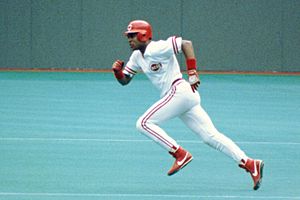
Team Captains
- Tommy Corcoran – 1900–1905
- Joe Kelley – 1906
- John Ganzel – 1907
- Hans Lobert – 1909
- Mike Mitchell – 1910–1912
- Ivey Wingo – 1916
- Heinie Groh – 1918–1921
- Jake Daubert – 1922–1924
- Edd Roush – 1925–1926
- Bubbles Hargrave – 1927–1928
- 14 Pete Rose – 1970–1978
- 13 Dave Concepción – 1983–1988
- 11 Barry Larkin – 1997–2004
Retired Jersey Numbers
The Cincinnati Reds have retired 10 jersey numbers. They also honor Jackie Robinson, whose number 42 is retired across all of Major League Baseball.
All retired numbers are displayed at Great American Ball Park behind home plate. Broadcasters Marty Brennaman, Waite Hoyt, and Joe Nuxhall are also honored with microphones near the broadcast booth.
|
On April 15, 1997, number 42 was retired across all of Major League Baseball to honor Jackie Robinson.
Baseball Hall of Fame Members
| Cincinnati Reds Hall of Famers | |||||||||
|---|---|---|---|---|---|---|---|---|---|
| Affiliation according to the National Baseball Hall of Fame and Museum | |||||||||
|
Ford C. Frick Award Winners
| Cincinnati Reds Ford C. Frick Award recipients | |||||||||
|---|---|---|---|---|---|---|---|---|---|
| Affiliation according to the National Baseball Hall of Fame and Museum | |||||||||
|
MLB All-Star Games Hosted by the Reds
The Reds have hosted the Major League Baseball All-Star Game five times. They hosted twice at Crosley Field (1938, 1953), twice at Riverfront Stadium (1970, 1988), and once at Great American Ball Park (2015).
Team Rivalries
Reds vs. Cleveland Guardians
The Ohio Cup was a yearly pre-season baseball game between the Ohio rivals, the Cleveland Guardians (formerly the Indians) and the Cincinnati Reds. It started in 1989 and was played in Columbus, Ohio. The winner received the Ohio Cup trophy.
Eight Ohio Cup games were played from 1989 to 1996, with the Guardians winning six times. These games were very popular with fans. The Ohio Cup games stopped when regular-season interleague play began in 1997. Now, the Ohio Cup is awarded to the team with the better record in the yearly Reds–Guardians series.
Reds vs. Pittsburgh Pirates
The Pirates-Reds rivalry was very strong in the National League during the 1970s. Both teams often met in the playoffs. They were both founded in the 1880s. Together, they have won 10 World Series championships and 18 pennants.
The Pirates and Reds played against each other in the NLCS five times (1970, 1972, 1975, 1979, and 1990). They also met in the 2013 NL Wild Card Game. As of 2023, the Pirates lead the overall series, but the Reds lead in postseason wins.
Reds vs. Los Angeles Dodgers
The Dodgers–Reds rivalry was very intense from the 1970s to the early 1990s. They often competed for the NL West division title. From 1970 to 1990, they frequently finished first and second in the standings.
Both teams won many championships during this time. Reds manager Sparky Anderson once said their rivalry was unique. The rivalry ended when the Reds moved to the NL Central division. However, they did play each other in the 1995 NLDS.
Reds Media Coverage
Radio Broadcasts

The Reds' main radio station has been WLW, 700AM, since 1969. Reds games can be heard on over 100 local radio stations through the Reds on Radio Network.
Since 2020, the Reds broadcast team has been Tommy Thrall and former Reds pitcher Jeff Brantley. Marty Brennaman called Reds games from 1974 to 2019. He was famous for his call, "... and this one belongs to the Reds!" after a win. He worked with former Reds pitcher Joe Nuxhall for many years.
Television Broadcasts
Televised Reds games that are not shown nationally are broadcast on FanDuel Sports Network Ohio and FanDuel Sports Network Indiana. George Grande, who hosted the first SportsCenter on ESPN, was the play-by-play announcer from 1993 until 2009.
In 2020, Thom Brennaman, who was the main TV play-by-play announcer, resigned. The Reds then hired John Sadak as their new television play-by-play announcer.
Community Involvement
The Reds Community Fund, started in 2001, helps young people in the Cincinnati area. It uses the traditions of the Reds to improve lives. The fund supports programs like Reviving Baseball in Inner Cities (RBI). This program helps young people graduate high school and go to college.
The fund also holds an annual telethon, raising a lot of money. For example, the fund renovated Hoffman Fields in Cincinnati, upgrading the entire recreation complex. They have renovated over 400 baseball fields in the region.
During the 2020 COVID-19 pandemic, when fans couldn't attend games, the Reds sold paper cutouts of fans' photos to place in the stands. This raised over $300,000 for the fund.
Team Roster
|
Cincinnati Reds 2023 spring training roster
|
||||||
|---|---|---|---|---|---|---|
| 40-man roster | Non-roster invitees | Coaches/Other | ||||
|
Pitchers
|
Catchers
Infielders
Outfielders
|
Pitchers
Catchers
Outfielders
|
Manager
Coaches
40 active, 0 inactive, 8 non-roster invitees
|
|||
Minor League Teams
The Cincinnati Reds have seven minor league teams. These teams help develop young players for the main Reds team.
| Class | Team | League | Location | Ballpark | Affiliated |
|---|---|---|---|---|---|
| Triple-A | Louisville Bats | International League | Louisville, Kentucky | Louisville Slugger Field | 2000 |
| Double-A | Chattanooga Lookouts | Southern League | Chattanooga, Tennessee | AT&T Field | 1988 |
| High-A | Dayton Dragons | Midwest League | Day Air Ballpark | 2000 | |
| Single-A | Daytona Tortugas | Florida State League | Daytona Beach, Florida | Jackie Robinson Ballpark | 2015 |
| Rookie | ACL Reds | Arizona Complex League | Goodyear, Arizona | Goodyear Ballpark | 1999 |
| DSL Reds | Dominican Summer League | Boca Chica, Santo Domingo | Baseball City Complex | 1998 | |
| DSL Rojos | 2024 |
See also
 In Spanish: Cincinnati Reds para niños
In Spanish: Cincinnati Reds para niños


